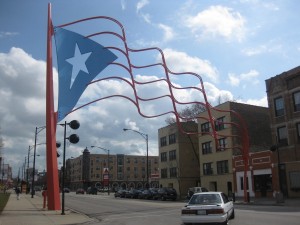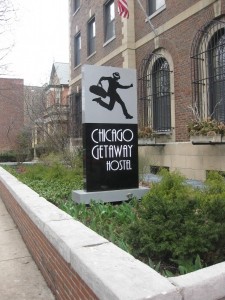Entries Tagged as 'Uncategorized'
March 16th, 2012 · Comments Off on Day 5: bittersweet ending
This last day in Chicago seemed to have the biggest impact. We took a driving tour of Southside Chicago and were able to see just how many disparities exist all within a 15 mile radius. Some Black residents of Southside live without the basic necessity of fresh groceries, while others are trapped within the confines of a complex because to venture into the Bridgeport neighborhood that is predominately Irish American is a death sentence. It is amazing to me to think that such extreme cases of segregation still exist today. For me, I have always known that segregation still exists, but I have never seen such a stark contrast of segregation within a neighborhood. You could actually see the differences within neighborhoods by just crossing a street. It isn’t until seeing a driving tour of Southside that I truly realized that Chicago is legitimately one of the most segregated cities in the nation. Fortunately, I was also able to see the more unknown affluent neighborhood of Southside Chicago. I passed by the homes of powerful political leaders such as Reverend Jesse Jackson, and was also able to see the former homes of Hugh Hefner and Muhammad Ali alike.
Next, we became familiar with the Christian Community Development Association (CCDA). The CCDA is a networking non-profit that is providing a way for people who want to restore under-resourced communities around the world. This organization has spread across America and offers a community outreach approach that carries Christian beliefs. This organization hit so close to home for me through its ideas that closely resemble those of the Act Six Scholarship Initiative that is stationed in Tacoma. Educate leaders that will come back and serve their community while also looking within the community for help. Such an organization as CCDA gives me hope as an Act Six Scholar that we are not alone in trying to restore the communities in which we see are under-resourced.
The finale of the trip was dinner and poetry at Soul Vegetarian! We started the night off with vegetarian/vegan twist on traditional soul food. But the best part of the night had to be the POETRY!!!!!!!! We were able to see the vibrant spoken word movement of Chicago up close and personal. It was refreshing to hear about common problems that we all face in an entire different city, but also hear from a Chicagoan’s perspective the difficulties they face living in a large urban city. Also, two of us, including myself, got up and shared our own poetry to show them Gonzaga’s poetic styling. Overall, Soul Vegetarian was the greatest way to end this trip. The poetry tonight was some of the greatest I’ve ever heard and its great experience to walk away from. Today, might have just been the best day of the trip, or just could have been me clinging to a trip that I think went way too soon…
Chare
Tags: Uncategorized
March 15th, 2012 · Comments Off on Day 5: African American history museum
Today we began our adventures at the DuSable Museum of African American History. At the museum you were able to see, hear and feel the pride that Chicago’s African American community has in their history, culture and people.
The DuSable Museum was started in the house of founder, Dr. Margaret Burroughs, in the hopes of preserving the experiences and achievements of people of African descent in America and especially in Chicago. The first exhibit Burroughs began was entitled, “Africa Speaks”. Formerly displayed in Burroughs living room, the exhibit highlights the differing art and artifacts from West, East, North and South Africa. Displaying everything from traditional beads and masks to chains captured slaves were imprisoned with on their journey to the Americas. Showing that despite the common misconception among the American public, Africa is full of a multitude of different cultures, histories, languages, and people. And despite a common skin color, and a common traumatic American history, African’s and African American’s are descended from a beautiful, multi-faceted history that has shaped them into the strong, preserving people they are today.
This importance the African American community places on the connection to your ancestors and their history makes one think about their own past. Born and raised in Honolulu, Hawaii, and being born with aboriginal Native Hawaiian blood I have experienced a different life, at least culturally, compared to many at GU. I can read, speak and understand much of the Hawaiian language. I can dance hula, I know the proper protocol and chants to ask enter to a sacred place, and to praise and thank the gods. Yet, despite all I claim to know about my culture, the DeSable Museum visit today has called this into question, it showed me how little I truly know about my people and their history. I don’t know the stories of those who sailed for months using only the stars for navigation to find the Hawaiian Islands, or the stories of those fought and died trying to save the Hawaiian Kingdom from illegal American overthrow. I don’t know the stories of my own people.
Following the museum tour, we took a tour of the south-side with Steve Saunders from Featherfist Agency. We ate lunch at one of Obama’s favorites, Valois Restaurant, and now we are on our way to the Christian Community Development Association followed by an awesome dinner and poetry at Soul Vegetarian.
A simply great way to end our visit in the Windy City!
Kahala
Tags: Uncategorized
March 15th, 2012 · Comments Off on Day 4: LGBT community and Loyola
Today we spent the first part of the day touring Chicago’s Halstead LGBT Center. It was an extremely eye-opening experience. So many topics and issues concerning the LGBT community were not only addressed in discussion but were also addressed by actions stemming from programs and initiatives implemented within the center to offer free assistance and support. The center offered so many resources (gym facilities, computer labs, theater involvement, culinary training, a hot line, HIV/AIDS testing, art exhibits, counseling sessions, senior citizen socials and assistance, and youth involvement) that it was nearly mind boggling how much of an impact this one building facility was making in the community. I was personally so inspired listening to how many volunteers offered hours of time of service in order to reach out to this often times impoverished and isolated community. Society definitely (and especially politics) does not make it easy for an individual to be openly gay even in this supposedly “progressive” modern day twenty-first century and it is refreshing to know that there are organizations out there that are dedicated to providing a safe and judgment free zone in any way that they can so that the LGBT minority group not only has specific resources available to them but also may experience a sense of compassion and understanding. We also had the privilege of meeting for lunch with a few multicultural students from Loyola University. Not only did we eat some delicious pizza but we also participated in open dialogue about some of the issues concerning both Gonzaga and Loyola both as private Catholic Jesuit institutions. It was very shocking to me that Loyola still managed to greatly lack diversity (as far as the number of students of color in attendance was concerned) even though its location was in the heart of one of the most diverse cities in the nation. The population of the city of Chicago contains 64% African Americans and Latinos. Even though the tuition is extremely high and seemingly unaffordable to the masses, the very familiar statistics (to Gonzaga’s own multicultural student makeup) served as very disappointing. However, I was also baffled by the vast differences existing between such similar institutions (having almost identical mission statements) concerning the incorporation of culture. First, Loyola has distinct cultural studies programs that are designated as an academic major (African American Studies or Latino Studies) whereas Gonzaga does not. Loyola put on a Drag Queen Fashion Show to honor their LGBT Appreciation and Awareness Month that was well received by both faculty members and students and resulted in a large number of attendees…..and for some reason I could not imagine a similar event taking place on Gonzaga’s campus. And last, the Vagina Monologues has been performed multiple times on Loyola’s campus without issues or censorship. The Loyola students were shocked at the fact that Gonzaga’s own desire to bring the Monologues to the stage was so controversial and all around discouraged. The director of Loyola’s Multicultural Center put it best when he said that as a Jesuit institution with a mission statement that promotes the preserving of human dignity in regards to all people…..we must do just that. It is not fair to pick and choose which human dignities we deem appropriate to respect or to support for that matter.
Jordan Love
Tags: Uncategorized
March 14th, 2012 · Comments Off on

Other end of the street

"The Three Tenors" soul concert


Tags: Uncategorized
March 14th, 2012 · Comments Off on
Tags: Uncategorized





